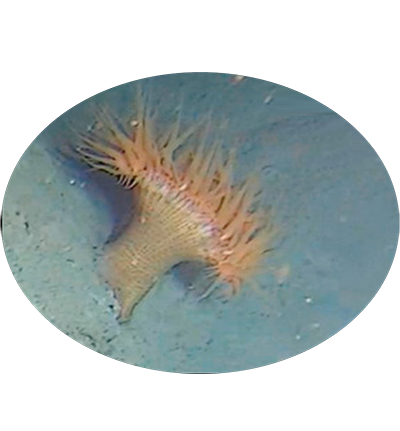
Deep-sea anemone species Paraphelliactis xishaensis sp. nov. is a newly described species of deep-sea anemone in the genus Paraphelliactis, discovered in the Xisha Trough of the South China Sea at a depth of 3,230 meters. This species is adapted to the extreme conditions of the deep sea, thriving in cold, dark, and high-pressure environments. Its discovery contributes to our understanding of the biodiversity and ecological dynamics of deep-sea ecosystems.
Animalia (Kingdom); Cnidaria (Phylum); Anthozoa (Subphylum); Hexacorallia (Class); Actiniaria (Order); Enthemonae (Suborder); Metridioidea (Superfamily); Hormathiidae (Family); Paraphelliactis (Genus); Paraphelliactis xishaensis (Species)
Paraphelliactis xishaensis Feng, Liu, Xu, Zhou, Zhu, Liu, Wu, Li, Qiu, He, Wang, Zhang & Wang, 2021
1. (Feng et al., 2021)
Morphologically, this deep-sea anemone has an orange-brown body and markedly expanded oral disc. The column is divisible into scapus and scapulus and regularly covered with dense tubercles. No cinclides. Internal column bears acontia. These lines of characteristics suggest this anemone should belong to the genus Paraphelliactis (Actiniaria, Hormathiidae), which is also established by molecular evidence
Xisha Trough (113.737502° E, 18.266465° N)
| Species | Phylum | Common Name | Ecosystem | Depth | Habitat | NCBI Taxonomy ID |
|---|---|---|---|---|---|---|
| Paraphelliactis xishaensis sp. nov. | Cnidaria | Paraphelliactis xishaensis | Deep sea | 3,230 | Xisha Trough (113.737502° E, 18.266465° N) | 2836328 |
| Genome Assembly | Genome Size | Assembly level | Released year | WGS accession | Submitter | BioProject | BUSCO completeness (%) | Scaffold/Contig N50 (kb) | GC content (%) | Repeat Rate (%) | Gene Number |
|---|---|---|---|---|---|---|---|---|---|---|---|
| - | 542.9Mb | Contig | 2021 | - | Northwestern Polytechnical University | PRJNA588374 | 89.50 | 761.1 | 37.5 | 56.6 | 32,549 |
| Title | Journal | Pubmed ID |
|---|---|---|
| The genome of a new anemone species (Actiniaria: Hormathiidae) provides insights into deep-sea adaptation | Deep Sea Research Part I | Link |
| Gene ID | Description |
|---|---|
| HK74SY85_g1 | IMPACT-RELATED |
| HK74SY85_g10 | PROTEIN MCM10 HOMOLOG |
| HK74SY85_g100 | TYROSINE-PROTEIN KINASE RECEPTOR |
| HK74SY85_g1000 | REVERSE TRANSCRIPTASE DOMAIN-CONTAINING PROTEIN |
| HK74SY85_g10000 | TUBULIN |
| HK74SY85_g10001 | DNA-DIRECTED RNA POLYMERASE I SUBUNIT 2 |
| HK74SY85_g10002 | BONUS, ISOFORM C-RELATED |
| HK74SY85_g10003 | CENTROSOMAL PROTEIN 2 |
| HK74SY85_g10004 | PROTEIN TAG-278-RELATED |
| HK74SY85_g10005 | PERICENTRIN-LIKE PROTEIN, ISOFORM F |
| HK74SY85_g10006 | BETA TRANSDUCIN-RELATED PROTEIN |
| HK74SY85_g10007 | - |
| HK74SY85_g10008 | BETA TRANSDUCIN-RELATED PROTEIN |
| HK74SY85_g10009 | DUF614 FAMILY PROTEIN-RELATED |
| HK74SY85_g1001 | SPERMATOGENESIS-ASSOCIATED SERINE-RICH PROTEIN 2-RELATED |
| HK74SY85_g10010 | LEUCINE-ZIPPER-LIKE TRANSCRIPTIONAL REGULATOR 1 |
| HK74SY85_g10011 | FAM124 DOMAIN-CONTAINING PROTEIN-RELATED |
| HK74SY85_g10012 | CYTOCHROME P450 |
| HK74SY85_g10013 | - |
| HK74SY85_g10014 | - |
| Annotation ID | Description | Type | Subtype | GeneRatio | Evolution Type | P-value | Q-value |
|---|---|---|---|---|---|---|---|
| GO:0071480 | cellular response to gamma radiation | GO | Biological Process | - | expanded | - | 1.93E-16 |
| GO:0036310 | annealing helicase activity | GO | Molecular Function | - | expanded | - | 6.10E-16 |
| GO:0000784 | nuclear chromosome, telomeric region | GO | Cellular Component | - | expanded | - | 9.15E-16 |
| GO:0006310 | DNA recombination | GO | Biological Process | - | expanded | - | 1.35E-15 |
| GO:0006298 | mismatch repair | GO | Biological Process | - | expanded | - | 3.72E-15 |
| GO:0000733 | DNA strand renaturation | GO | Biological Process | - | expanded | - | 5.15E-15 |
| GO:0006289 | nucleotide-excision repair | GO | Biological Process | - | expanded | - | 1.20E-14 |
| GO:0003690 | double-stranded DNA binding | GO | Molecular Function | - | expanded | - | 6.47E-14 |
| GO:0098794 | postsynapse | GO | Cellular Component | - | expanded | - | 3.11E-12 |
| GO:0006303 | double-strand break repair via nonhomologous end joining | GO | Biological Process | - | expanded | - | 5.10E-12 |
| GO:0000723 | telomere maintenance | GO | Biological Process | - | expanded | - | 2.08E-11 |
| GO:0005044 | scavenger receptor activity | GO | Molecular Function | - | expanded | - | 1.44E-10 |
| GO:0006898 | receptor-mediated endocytosis | GO | Biological Process | - | expanded | - | 1.44E-10 |
| GO:0005739 | mitochondrion | GO | Cellular Component | - | expanded | - | 1.12E-09 |
| GO:0008310 | single-stranded DNA 3'-5' exodeoxyribonuclease activity | GO | Molecular Function | - | expanded | - | 6.53E-08 |
| GO:0000712 | resolution of meiotic recombination intermediates | GO | Biological Process | - | expanded | - | 5.80E-07 |
| GO:0003677 | DNA binding | GO | Molecular Function | - | expanded | - | 7.18E-06 |
| GO:0009299 | mRNA transcription | GO | Biological Process | - | expanded | - | 1.38E-05 |
| GO:0015074 | DNA integration | GO | Biological Process | - | expanded | - | 5.40E-05 |
| GO:0098655 | cation transmembrane transport | GO | Biological Process | - | expanded | - | 7.00E-05 |

